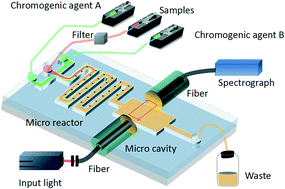Our official English website, www.x-mol.net, welcomes your feedback! (Note: you will need to create a separate account there.)
Optofluidic marine phosphate detection with enhanced absorption using a Fabry–Pérot resonator
Lab on a Chip ( IF 6.1 ) Pub Date : 2017-10-25 00:00:00 , DOI: 10.1039/c7lc01016h J. M. Zhu 1, 2, 3, 4, 5 , Y. Shi 1, 2, 3, 4, 5 , X. Q. Zhu 1, 2, 3, 4, 5 , Y. Yang 1, 2, 3, 4, 5 , F. H. Jiang 5, 6 , C. J. Sun 5, 6 , W. H. Zhao 5, 7, 8 , X. T. Han 5, 7, 8
Lab on a Chip ( IF 6.1 ) Pub Date : 2017-10-25 00:00:00 , DOI: 10.1039/c7lc01016h J. M. Zhu 1, 2, 3, 4, 5 , Y. Shi 1, 2, 3, 4, 5 , X. Q. Zhu 1, 2, 3, 4, 5 , Y. Yang 1, 2, 3, 4, 5 , F. H. Jiang 5, 6 , C. J. Sun 5, 6 , W. H. Zhao 5, 7, 8 , X. T. Han 5, 7, 8
Affiliation

|
Real-time detection of phosphate has significant meaning in marine environmental monitoring and forecasting the occurrence of harmful algal blooms. Conventional monitoring instruments are dependent on artificial sampling and laboratory analysis. They have various shortcomings for real-time applications because of the large equipment size and high production cost, with low target selectivity and the requirement of time-consuming procedures to obtain the detection results. We propose an optofluidic miniaturized analysis chip combined with micro-resonators to achieve real-time phosphate detection. The quantitative water-soluble components are controlled by the flow rate of the phosphate solution, chromogenic agent A (ascorbic acid solution) and chromogenic agent B (12% ammonium molybdate solution, 80% concentrated sulfuric acid and 8% antimony potassium tartrate solution with a volume ratio of 80 : 18 : 2). Subsequently, an on-chip Fabry–Pérot microcavity is formed with a pair of aligned coated fiber facets. With the help of optical feedback, the absorption of phosphate can be enhanced, which can avoid the disadvantages of the macroscale absorption cells in traditional instruments. It can also overcome the difficulties of traditional instruments in terms of size, parallel processing of numerous samples and real-time monitoring, etc. The absorption cell length is shortened to 300 μm with a detection limit of 0.1 μmol L−1. The time required for detection is shortened from 20 min to 6 seconds. Predictably, microsensors based on optofluidic technology will have potential in the field of marine environmental monitoring.
中文翻译:

使用Fabry-Pérot共振器增强吸收性的光流体海洋磷酸盐检测
磷酸盐的实时检测在海洋环境监测和预测有害藻华的发生中具有重要意义。传统的监测手段依赖于人工采样和实验室分析。由于设备尺寸大,生产成本高,目标选择性低以及需要耗时的过程来获得检测结果,因此它们在实时应用中具有各种缺点。我们提出了一种结合微谐振器的光流体微型化分析芯片,以实现实时磷酸盐检测。通过磷酸盐溶液,发色剂A(抗坏血酸溶液)和发色剂B(12%钼酸铵溶液,80%的浓硫酸和8%的酒石酸锑钾溶液,体积比为80:18:2)。随后,芯片上的Fabry-Pérot微腔形成了一对对齐的涂层纤维小平面。借助光反馈,可以增强磷酸盐的吸收,从而避免了传统仪器中大型吸收池的弊端。它还可以克服传统仪器在尺寸,并行处理大量样本和实时监控方面的困难,可以避免传统仪器中大型吸收池的弊端。它还可以克服传统仪器在尺寸,并行处理大量样本和实时监控方面的困难,可以避免传统仪器中大型吸收池的弊端。它还可以克服传统仪器在尺寸,并行处理大量样本和实时监控方面的困难,等的吸收池长度缩短至300μm以0.1微摩尔升的检测限-1。检测所需的时间从20分钟缩短到6秒。可以预见,基于光流技术的微传感器将在海洋环境监测领域中具有潜力。
更新日期:2017-11-01
中文翻译:

使用Fabry-Pérot共振器增强吸收性的光流体海洋磷酸盐检测
磷酸盐的实时检测在海洋环境监测和预测有害藻华的发生中具有重要意义。传统的监测手段依赖于人工采样和实验室分析。由于设备尺寸大,生产成本高,目标选择性低以及需要耗时的过程来获得检测结果,因此它们在实时应用中具有各种缺点。我们提出了一种结合微谐振器的光流体微型化分析芯片,以实现实时磷酸盐检测。通过磷酸盐溶液,发色剂A(抗坏血酸溶液)和发色剂B(12%钼酸铵溶液,80%的浓硫酸和8%的酒石酸锑钾溶液,体积比为80:18:2)。随后,芯片上的Fabry-Pérot微腔形成了一对对齐的涂层纤维小平面。借助光反馈,可以增强磷酸盐的吸收,从而避免了传统仪器中大型吸收池的弊端。它还可以克服传统仪器在尺寸,并行处理大量样本和实时监控方面的困难,可以避免传统仪器中大型吸收池的弊端。它还可以克服传统仪器在尺寸,并行处理大量样本和实时监控方面的困难,可以避免传统仪器中大型吸收池的弊端。它还可以克服传统仪器在尺寸,并行处理大量样本和实时监控方面的困难,等的吸收池长度缩短至300μm以0.1微摩尔升的检测限-1。检测所需的时间从20分钟缩短到6秒。可以预见,基于光流技术的微传感器将在海洋环境监测领域中具有潜力。


























 京公网安备 11010802027423号
京公网安备 11010802027423号